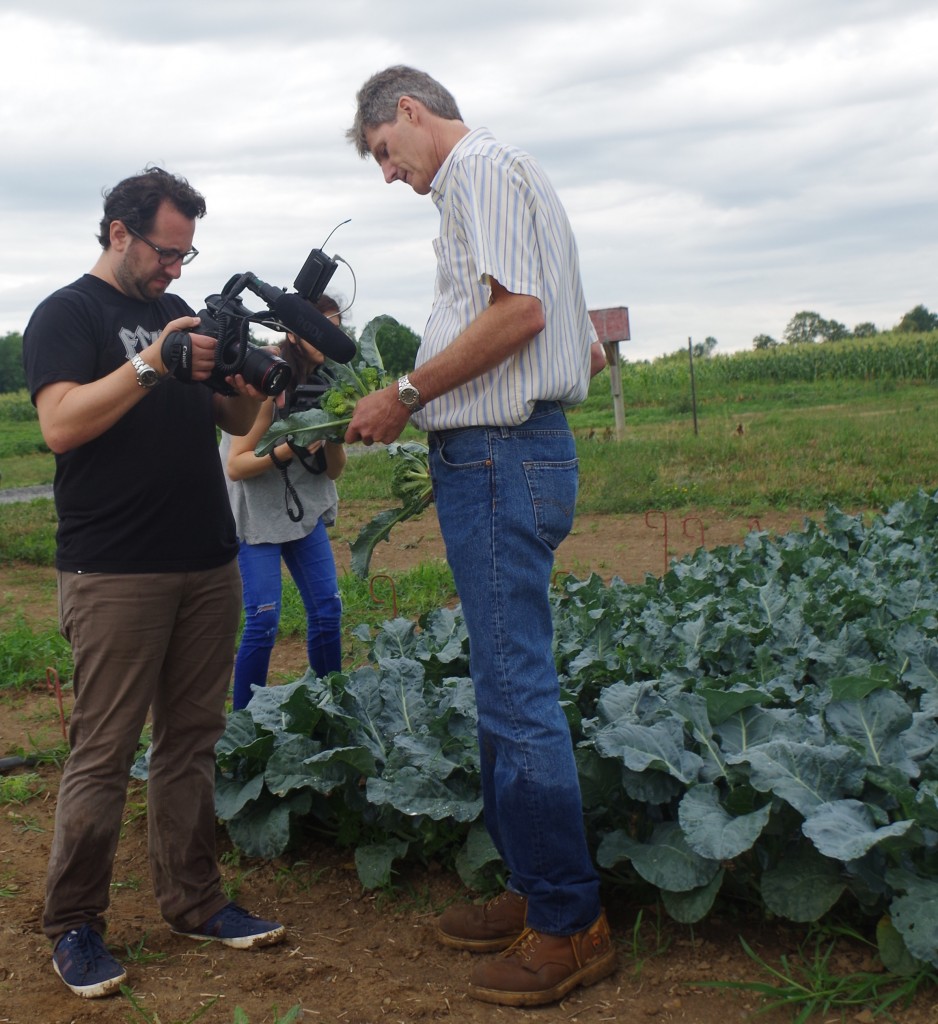The last planting of the season is starting to head in Hastings, FL, a major winter-production region for Eastern broccoli. University of Florida Prof. Lincoln Zotarelli is running both Quality and Yield Trials in Hastings so adaptation to this production system is addressed Continue reading Spring broccoli in Hastings, Florida
All posts by Thomas Björkman
Southeast broccoli sites survive Matthew deluge
Hurricane Matthew brought ten inches of rain to two of our research locations. Both Hastings, Florida and Charleston, South Carolina were in the heaviest rainfall zones. Continue reading Southeast broccoli sites survive Matthew deluge
Broccoli is the future of food
Producers Rebecca Davis and Matt Toder of NBC Universal visited our trial site in Geneva to film a segment for their new feature on The Future of Food. The future does look bright for broccoli! Thanks for making us part of the story.

Funded again!
The Eastern Broccoli Project was successful in its renewal application, so we are moving ahead for another five years. We were awarded two years of funding and approved for an additional three years. Thanks very much to all the collaborators who made this such a high-ranking application, and to the USDA-NIFA Specialty Crops Research Initiative for funding it.
As we ramp up activities during September, you will see more news on this blog.
Summer adaptation gets even better
The Eastern Broccoli breeding pipeline is producing some great advances. Here is an inbred line from Mark Farnham’s program photographed in the depth of the South Carolina summer.

In these growing conditions, existing varieties produce heads with significant distortion. Area growers currently don’t harvest until fall to beat the heat. This inbred can be the basis of an expanded production season.
This inbred is a candidate for a public release or protection by a Plant Variety Patent. It would be used as a parental line in a commercial hybrid variety to contribute unprecedented adaptation to the Eastern summer growing conditions. We are working with cooperating seed companies to that end.
Broccoli is popular across ages, incomes and weights
That young children dislike broccoli is a commonly held assumption. Many parents know that is entirely untrue, as their small children gobble up the little trees with abandon. USDA offers consumption statistics that help inform this question. It turns out that young children, both boys and girls eat nearly as much broccoli among their vegetables as adults to. The drop occurs with teenagers, particularly boys. Young women start eating broccoli sooner than young men, but it becomes a larger part of their vegetable consumption as they get older.

The statistics also show the broccoli consumption is similar among low income, mid-income, and high income consumers. There are small differences in total vegetable consumption among income groups, but not enough to support the common impression that low income consumers are not getting vegetables.
Broccoli consumption is also consistent among weight categories. There is little difference among consumers who are healthy weight, overweight, or obese. Notably, obese children eat slightly more broccoli than their lighter counterparts.
Broccoli is a large share of cooking vegetables e
Eden Valley Field Day showcases high performing broccoli
At the Eden Valley twilight meeting, Christy Hoepting discussed variety performance with prospective growers in the new packing area of the W.D Henry and Sons. 
Later, in the field, the Phase III yield trial showed that the new varieties from the project were holding up well in the heat, where the older varieties were suffering.
Our collaborators at Johnny’s Selected Seed have a nice article on timing brassica planting. The article includes good examples of how different brassicas, including broccoli, modify their development in response to temperature. They mention Imperial as the most summer-tolerant in their line. In our trials, two varities that Johnny’s carries, Imperial and Bay Meadows, are standards that have been the ones to beat.
Produce Business on southern vegetable expansion
In the May issue of Produce Business, there is an article on the rapid growth in demand for locally grown vegetables in the southeast. That article is a special box about new varieties. the article highlights broccoli as a key vegetable that has been seeing an effort by regional growers. Powell Smith is quoted about adapting kale production to hot sandy soil, and also noting the sad fact that it has been a decade since Clemson had a vegetable breeding program. Our new collaborator, Tim Coolong at the University of Georgia outlines the many qualities required in varieties for them to thrive in the southeast.
The long search for May-harvested broccoli
A century ago, growers were also eager for broccoli varieties that could be harvested later into spring and early summer.

Some of the finest strains of late broccoli, however, are not in commerce, being in the hands of market-men, who have been selecting and re-selecting the stock for the last two or three generations, and from whom it is impossible to beg or buy even a single seed. In course of time, however, these will doubtless pass into the seeds men’s hands, when several late strains, later than anything at present in commerce, will be added to our list of useful varieties.
— F. W. Hammond. Pilgrim’s Hatch, Essex.
In The Garden, February 1917.
This article is about white broccoli, which was raised in England in the late 19th and early 20th century. It looked virtually identical to cauliflower but was cold hardy and raised for cold-season harvest. It was typically planted in the spring and harvested in either late fall or early the following spring. Biennial types headed and were harvested in the spring, but had little heat tolerance. Growers eagerly wanted late varieties that could be harvested in May and still look good.
